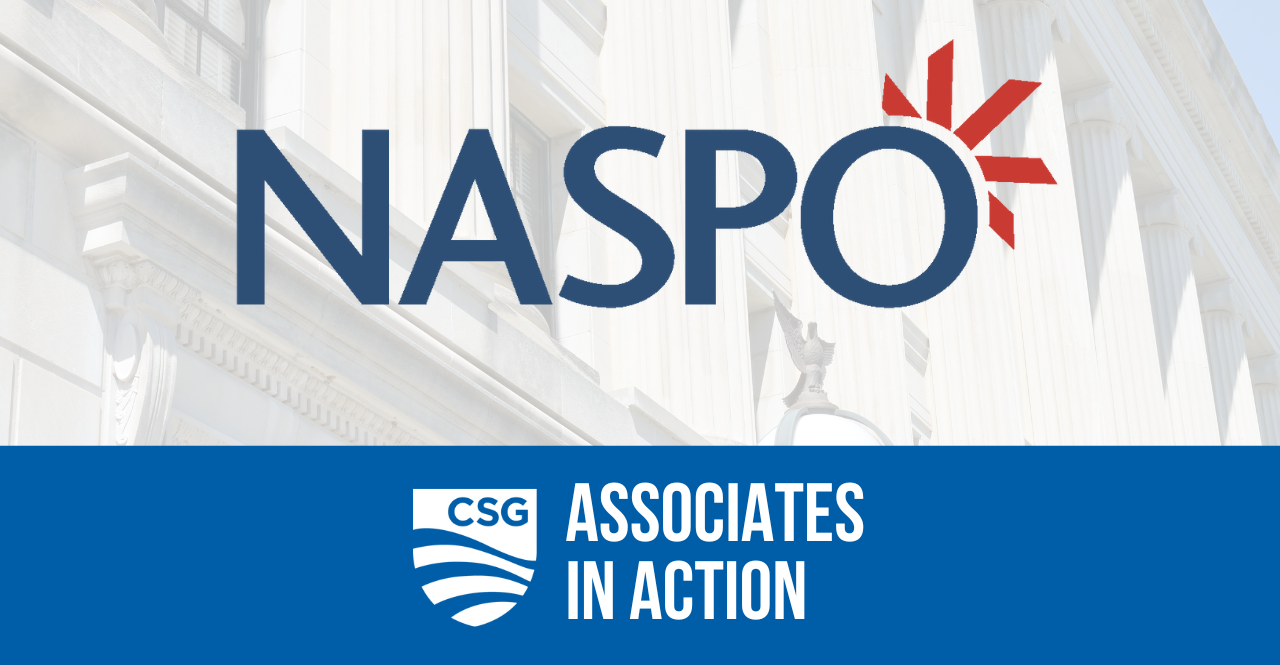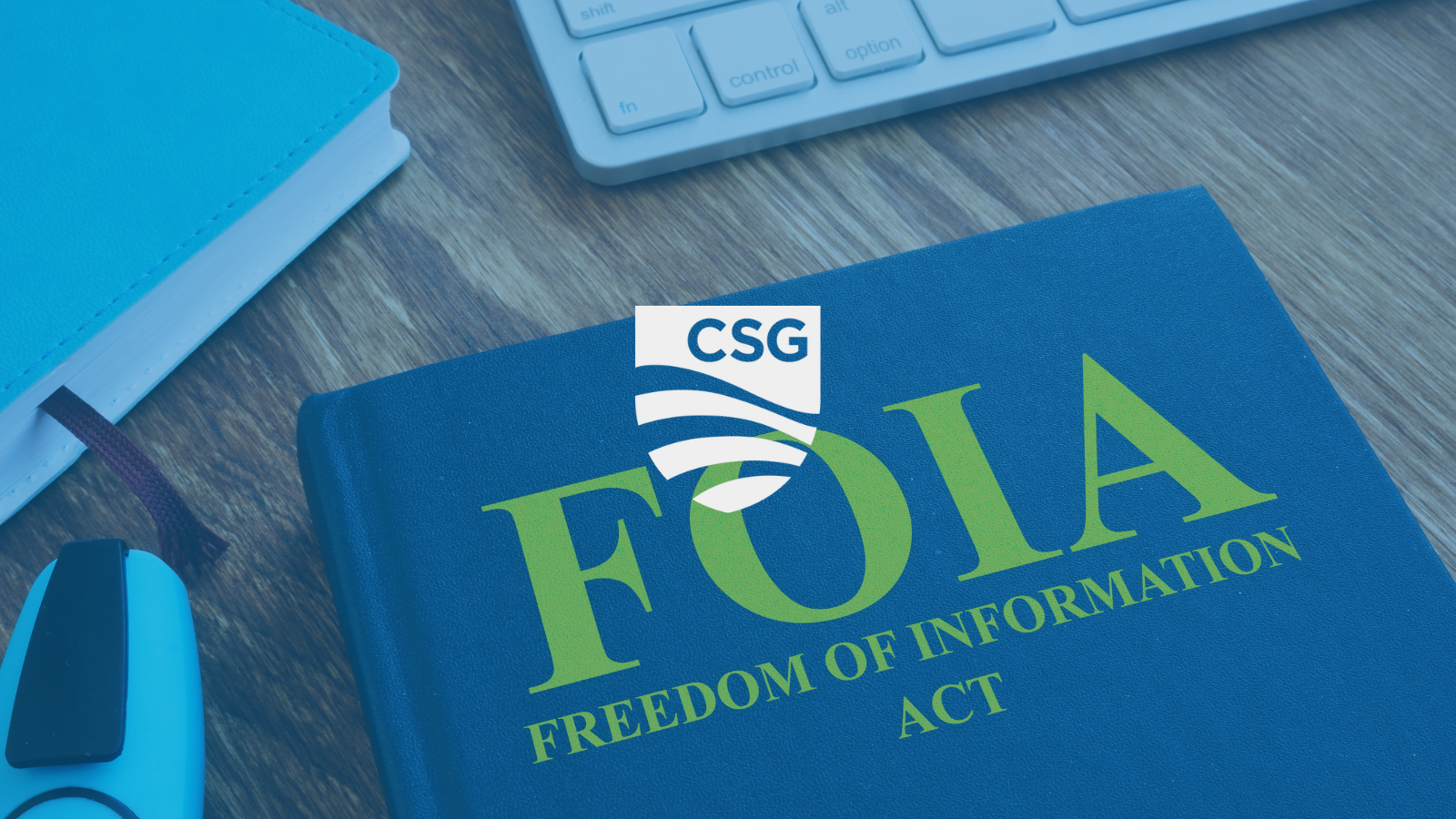The post Explainer: Key Findings from Vermont’s Domestic Violence Justice Reinvestment Initiative appeared first on CSG Justice Center.
U.S. Department of Energy Announces Funding Opportunity Awards (FOA) for State & Local Governments to Advance Clean Energy Technologies and Solutions
The U.S. Department of Energy (DOE) recently announced a wide range of funding opportunities available to state and local governments aimed at incentivizing smart manufacturing technologies, improve energy efficiency, workforce development and other strategies to support clean energy goals. See below for several funding opportunities which may be of interest to western leaders, including those pertaining to tribal lands, agricultural sector, and remote or rural areas.
State Manufacturing Leadership Program: Provides up to $50 million to work with States to accelerate use of smart manufacturing technologies and practices and access to tools and assistance. Available until expended.
Large Wind Turbine Materials and Manufacturing: Issued to further develop broad, foundational, manufacturing “platform” technologies and address gaps and barriers that are currently limiting use of composite materials in clean energy and decarbonization-related applications with wind energy applications as the primary focus. Deadline: May 9.
Reducing Agricultural Carbon Intensity and Protecting Algal Crops (RACIPAC): Develops science-based strategies and technologies to cost-effectively transform renewable carbon resources such as agricultural waste and algae into high-quality, environmentally sustainable, conversion-ready feedstocks for biofuels and bioproducts. Deadline: May 16.
Clean Energy Technology Deployment on Tribal Lands: The DOE Office of Indian Energy is soliciting applications from Indian Tribes, which include Alaska Native Regional Corporations and Village Corporations, Intertribal Organizations, and Tribal Energy Development Organizations to: (1) Install clean energy generating system(s) and energy efficiency measure(s) for Tribal Building(s); or, (2) Deploy community-scale clean energy generating system(s) or energy storage on Tribal Lands; or, (3) Install integrated energy system(s) for autonomous operation (independent of the traditional centralized electric power grid) to power a single or multiple Essential Tribal Buildings during emergency situations or for tribal community resilience; or, (4) Provide electric power to unelectrified tribal buildings. Deadline: May 16.
Carbon Capture Demonstration Projects Program: Provides $2.5 billion to develop six carbon capture facilities to significantly improve the efficiency, effectiveness, costs, emissions reductions, and environmental performance of coal and natural gas use. Deadline: May 23.
Energizing Rural Communities Prize: $15 million prize for entrepreneurs, university faculty and student groups, community organizations, tribal and local governments, financial institutions, industry professionals, and others with ideas to help organize or finance a clean energy demonstration project in a rural or remote area. Deadline: May 24 (Phase I applications)
Civil Nuclear Credit Program (CNC) Application Guidance: The second award cycle for the Civil Nuclear Credit program is open to owners or operators of nuclear reactors that are at risk of closure by the end of the four-year award period, including such reactors that ceased operations after November 15, 2021. Deadline: May 31.
Advanced Energy Manufacturing and Recycling Grants: This first FOA will provide approximately $350 million in awards to small- and medium-sized manufacturers in energy communities to 1) establish new facilities or 2) re-equip or expand existing facilities for the manufacturing or recycling of advanced energy property. Awards will focus on projects with high supply chain impacts and strong community benefits plans. Deadline: June 8.
EERE BETO FY23 Conversion Research and Development Funding Opportunity Announcement: Supports developing technologies to enable the conversion of waste and renewable resources to fuels and products with substantial greenhouse gas emissions reductions compared to the petroleum incumbent. Deadline: June 16
Carbon Capture Large-Scale Pilots: Designed to establish a carbon capture technology program for the development of transformational technologies that will significantly improve the efficiency, effectiveness, costs, emissions reductions, and environmental performance of coal and natural gas use, including in manufacturing and industrial facilities. Deadline: June 21.
Energy Improvements in Rural and Remote Areas (ERA): The Energy Improvements in Rural or Remote Areas (ERA) program seeks to improve the resilience, reliability, and affordability of energy systems in communities across the country with 10,000 or fewer people. Deadline: June 28
Clean Hydrogen Electrolysis, Manufacturing, and Recycling: Provides up to $750 million in Federal funding to support the broader government-wide approach to accelerate progress in clean hydrogen technologies and maximize the benefits of the clean energy transition. Deadline: July 19.
Industrial Demonstrations Program: Funds projects that focus on the highest emitting and hardest to abate industries where decarbonization technologies can have the greatest impact. Deadline: August 4.
Clean Energy Innovator Fellowship: A unique workforce development program that matches recent graduates and new energy professionals to key energy organizations to support efforts to advance clean energy solutions. Fellows will gain career experience with critical regional, state, utility, and tribal energy organizations.
EECBG Formula Program Funding Opportunity: The Energy Efficiency and Conservation Block Grant (EECBG) Program Formula Grant Application is now open to apply for $430 million in clean energy and energy efficiency funding. Read more about eligibility lists for states, local governments, and tribes.
IRA Funded Technical Assistance for Building Energy Codes: DOE’s Office of State and Community Energy Programs (SCEP) has announced its intent to make $1 billion in funding available to states and local governments for improved building codes that reduce carbon emissions and improve energy efficiency through the IRA Funded Technical Assistance for the Adoption of Building Energy Codes. This technical assistance opportunity will make two types of Building Code Technical Assistance available:
- $317 million will be available to adopt the latest building energy code, or other codes and standards that achieve equivalent or greater energy savings.
- $633 million will be used to adopt a building energy code that meets or exceeds the zero energy provisions in the 2021 IECC code, or other codes and standards with equivalent or greater energy savings.
The post U.S. Department of Energy Announces Funding Opportunity Awards (FOA) for State & Local Governments to Advance Clean Energy Technologies and Solutions appeared first on CSG West.
Associates in Action: NASPO Launches Program Supporting Member Certification
By Julie Stahl
The National Association of State Procurement Officials launched a new reimbursement program for public procurement professionals in March as part of its celebration of National Procurement Month. NASPO is a CSG Associate and nonprofit association committed to supporting public procurement leaders and promoting government excellence by delivering superior procurement solutions for public benefit.
The new NASPO program offers full reimbursement of the application and examination fees for qualified candidates in 2023 who pass the certification exams offered by the Universal Public Procurement Certification Council, or UPPCC. The UPPCC is an independent organization formed to govern and administer the Certified Public Procurement Officer and Certified Professional Public Buyer certification programs.
“Now is a great time for CSG members to encourage their procurement personnel to consider certification,” said David Gragan, NASPO chief administrative and strategic operations officer. “Those who pass the public procurement certification exams offered by the UPPCC can receive 100% reimbursement provided by the National Association of State Procurement Officials. This is another example of how NASPO strives daily to elevate the public procurement profession.”
The Certified Public Procurement Officer exam focuses on the six UPPCC Body of Knowledge and Competency domain areas: legal framework, procurement planning and analysis, sourcing and solicitation, contract development and management, leadership and business principles. The Certified Professional Public Buyer exam tests practice-level knowledge of the domain areas required for proficiency. The UPPCC Body of Knowledge and Competency domain areas for both exams can be found here.
NASPO provides its membership with highly beneficial programs, research, publications, innovative procurement strategies and professional development opportunities. Procurement professionals seek to serve as champions of the populace’s interests and demonstrate dedication to ethical best practices. NASPO continues to promote their mission and values by curating beneficial programs elevating the public procurement profession. For further information about UPPCC and procurement certifications, please visit uppcc.org.
Honoring National Crime Victims’ Rights Week and Sexual Assault Awareness Month
The post Honoring National Crime Victims’ Rights Week and Sexual Assault Awareness Month appeared first on CSG Justice Center.
Nongovernment Entities’ Inclusion in Public Records Law
By Valerie Newberg
Public records law, which is also recognized in select states as the Freedom of Information Act/Law, Sunshine Law, Right to Know Law or Open Records Law, is a tool intended to ensure government transparency and accountability by mandating the storage and release of documents to members of the public.
There are wide variations in each state’s version of the law. In certain states, agencies are required to respond within a timeframe ranging from three days to 12 weeks, while others designate maximum fees agencies may charge for the reproduction and transfer of records. Additionally, select states apply fees or criminal penalties to government agents who fail to comply with records requests. Some data is typically exempt from public records requests, including information that would constitute an invasion of privacy for institutions like hospitals, law enforcement agencies and schools, trade secrets, building maps, emergency procedures and firearms records.
Most laws are broadly inclusive of the state agencies subject to public records requests, with at least 19 states also setting statutory guidelines that explicitly require the category of quasi-governmental bodies, government sponsored entities and quasi nongovernmental agencies to comply with public records requests. For at least 12 states, court rulings have set criteria for nongovernmental bodies required to provide requested records. These bodies are typically defined as private entities including nonprofits, for-profits, tax districts and privatized government agencies that are partially supported by tax funding, use state resources, or perform some duties of the state. For example, Texas law defines governmental bodies as including nonprofit corporations that provide water and wastewater services, thus serving a public function.
Inclusion of Nongovernmental Bodies via Statute
Nineteen state statutes reference the participation of nongovernmental bodies in open records requests, while also providing financial or functional criteria for their inclusion. These states include:
- California.
- Delaware.
- Georgia.
- Indiana.
- Iowa.
- Kansas.
- Kentucky.
- Louisiana.
- Michigan.
- Missouri.
- Nebraska.
- North Dakota.
- Oklahoma.
- Rhode Island.
- South Carolina.
- Texas.
- Utah.
- Virginia.
- Wisconsin.
Financial standards for inclusion range from receipt of any government funding, like in North Dakota, to receipt of 33 ⅓% of its general operating budget from public funding, like in Georgia.
Functional guidelines are used in some states to determine a state’s inclusion; Missouri’s Sunshine Law states that a public body is one that performs a governmental function or enters into contracts with the government. States like Delaware combine these criteria, defining applicable nongovernmental entities as those who receive or disperse public funding, or who advise and contract with official government agencies.
Additionally, while Idaho does not explicitly include nongovernmental bodies in its statute, the state prohibits agencies from entering into contracts with them to avoid open records requests.
Inclusion of Nongovernmental Bodies via the Courts
In many states where public body or public entity is vaguely defined in the statute and may not explicitly include private organizations, the judiciary has settled disputes over the inclusion of these terms. In such legal decisions, judges typically apply a test consisting of between four and nine parts that set criteria for the entities’ definition as a public body. These tests were first employed by federal courts in clarifying application of the Federal Freedom of Information Act to nongovernmental entities but have since served as guidance for interpretation in state courts.
Connecticut, Ohio, Tennessee, Vermont and Washington use a four-part test defining nongovernmental agencies according to: (1) whether the entity performs a governmental function; (2) the level of governmental funding; (3) the extent of governmental involvement or regulation; and (4) whether the entity was created by the government.
West Virginia uses a five-part test that considers the composition of the entity’s governing board and if the entity operates statewide. Oregon uses a six-part test that also includes the ability of the entity to make binding government decisions, and the status of the entity’s employees as government or nongovernment employed. Colorado, Florida and New Mexico apply a slightly different nine-part test that also considers whether the entity mixes funds with the government through use of the state treasury, if the entity conducts business on publicly owned property, and whether the government has “substantial financial interest” in the entity.
Other state courts, like those of Arkansas, apply a simpler test permitting private agencies receiving public funds to be subject to open records requests. In Pennsylvania, any nongovernmental body performing government business or nonprofit renting public property for more than $1.5 million per year is required to abide by open records laws.
However, there remain states without guidance from judicial or legislative bodies on the inclusion of nongovernmental entities. In states like Alabama, Alaska, Arizona, Idaho, Mississippi, Montana, Nevada and South Dakota, the law does not specify a state’s inclusion and no court cases requiring private bodies to submit to records requests could be found. In Illinois, courts ruled that the receipt of public funding is insufficient in deeming a body public for the purpose of their law, and that the government must play a more active role in the decision-making and day-to-day operations of a company.
Participation of nongovernment entities in public records requests is only becoming more relevant as states look to privatize certain programs and agencies to decrease operating costs and risks. By setting clear statutory guidelines for inclusion and remaining informed on the issue, policymakers can anticipate how changes to the operation of their state will impact the distribution of information to taxpayers.
On the Road with CSG West: Hawaii
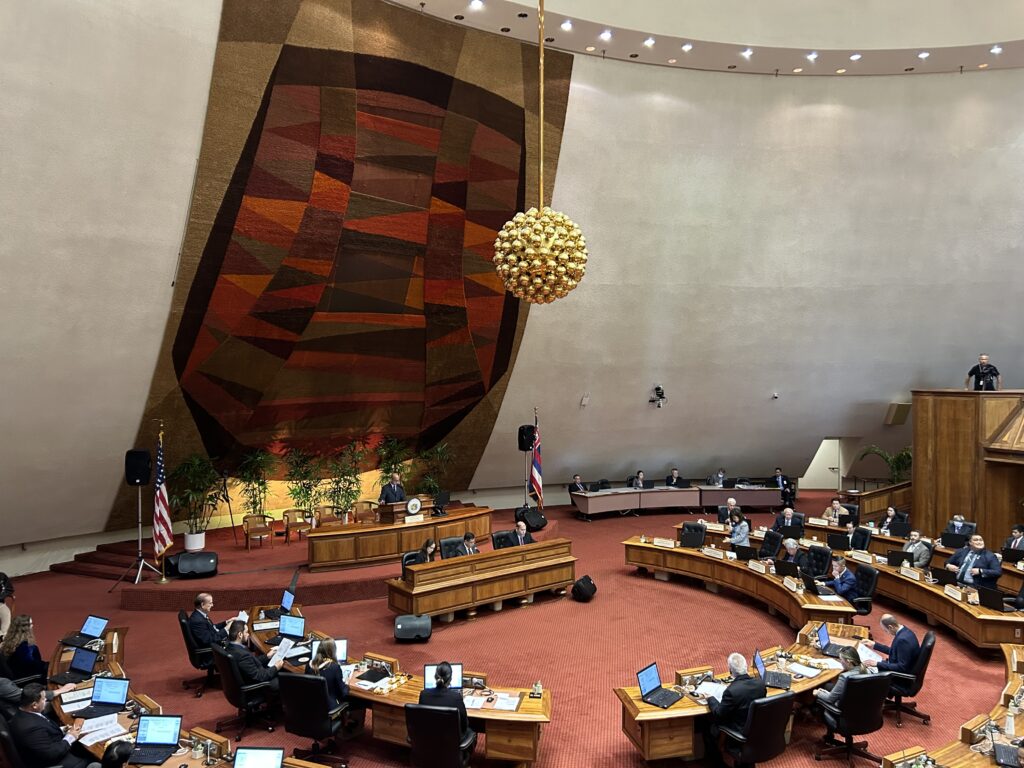
Last month, CSG West staff Edgar Ruiz and Will Keyse felt the Aloha spirit during the annual state visit to the Hawaii State Capitol in Honolulu. Many thanks to Senate Majority Leader Dru Kanuha and his wonderful staff for hosting us during the visit. We were able to connect with many members and staff to provide information on CSG West programs and services for the year, as well as learn of pertinent challenges facing the state.
A highlight of the visit included a breakfast gathering for alumni of the Western Legislative Academy (WLA) and members eligible for this year’s WLA. We thank the 45 members that came to join us and celebrate regional professional development. Mahalo to Sen. Chris Lee for the breakfast introduction, and to Senate Majority Leader Kanuha and Representative Troy Hashimoto for the introductions on the Senate and House floors, respectively.
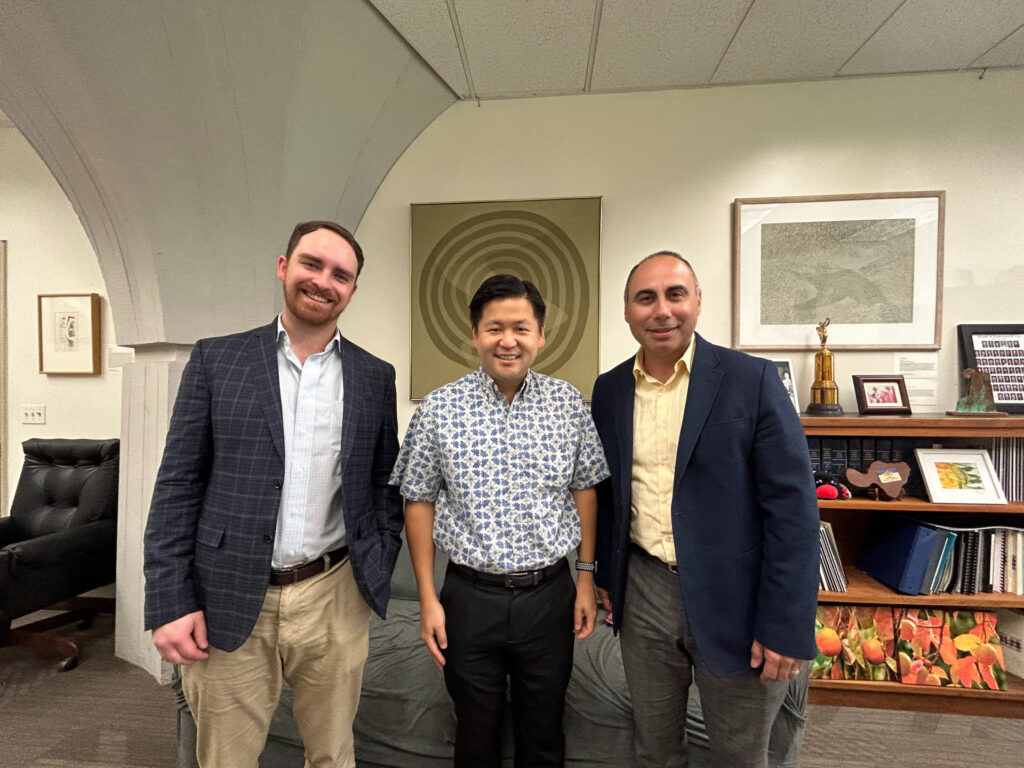
In addition to conversations with the leadership teams of Senate President Ronald Kouchi and Speaker Scott Saiki, CSG West staff were grateful to connect with Housing Committee Chairs Rep. Troy Hashimoto and Sen. Stanley Chang and thank them for their initiative in gathering Western housing committee chairs.
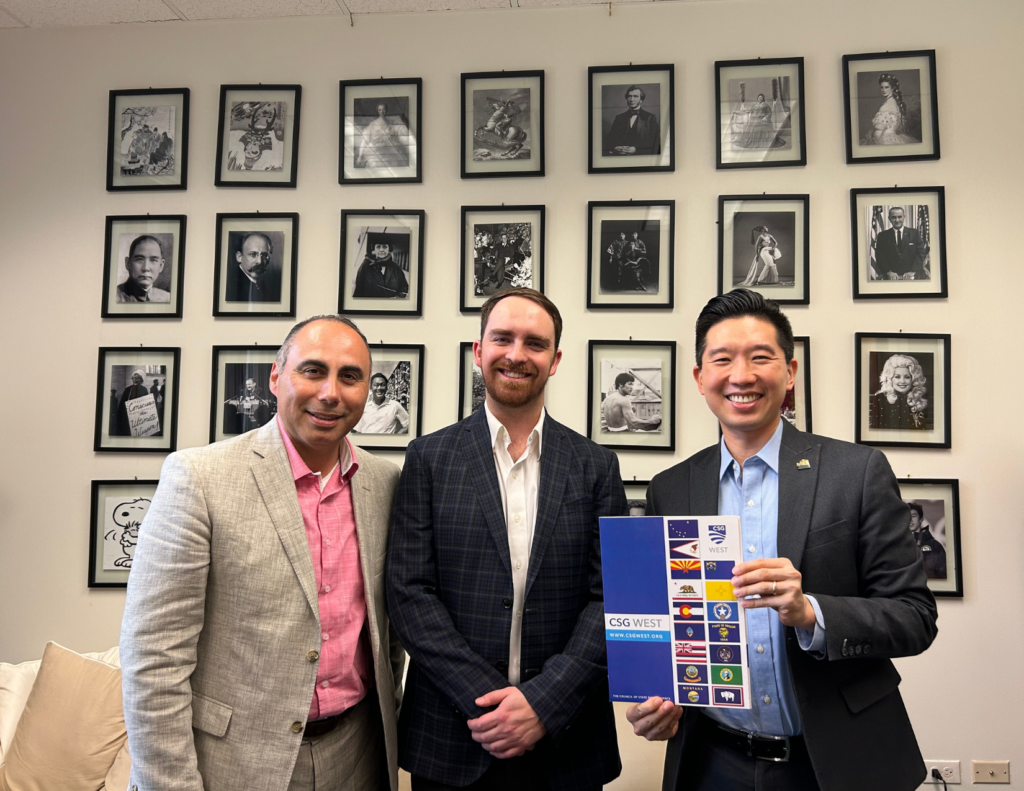
We appreciated the insight from each of the Hawaiian members on issues facing the legislature in Oahu and the neighbor islands, and look forward to seeing many of you this summer at the 76th CSG West Annual Meeting in Los Angeles in August.
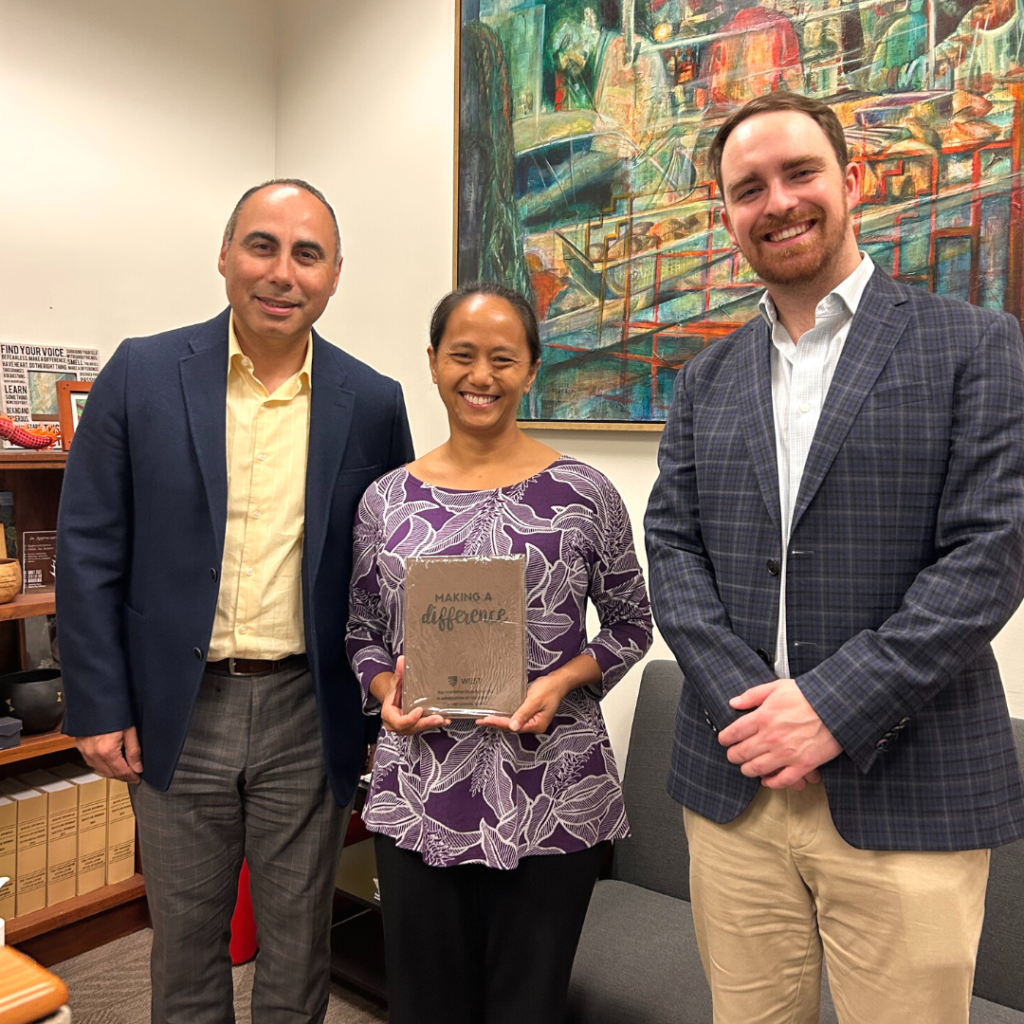
The post On the Road with CSG West: Hawaii appeared first on CSG West.
On the Road with CSG West: Montana
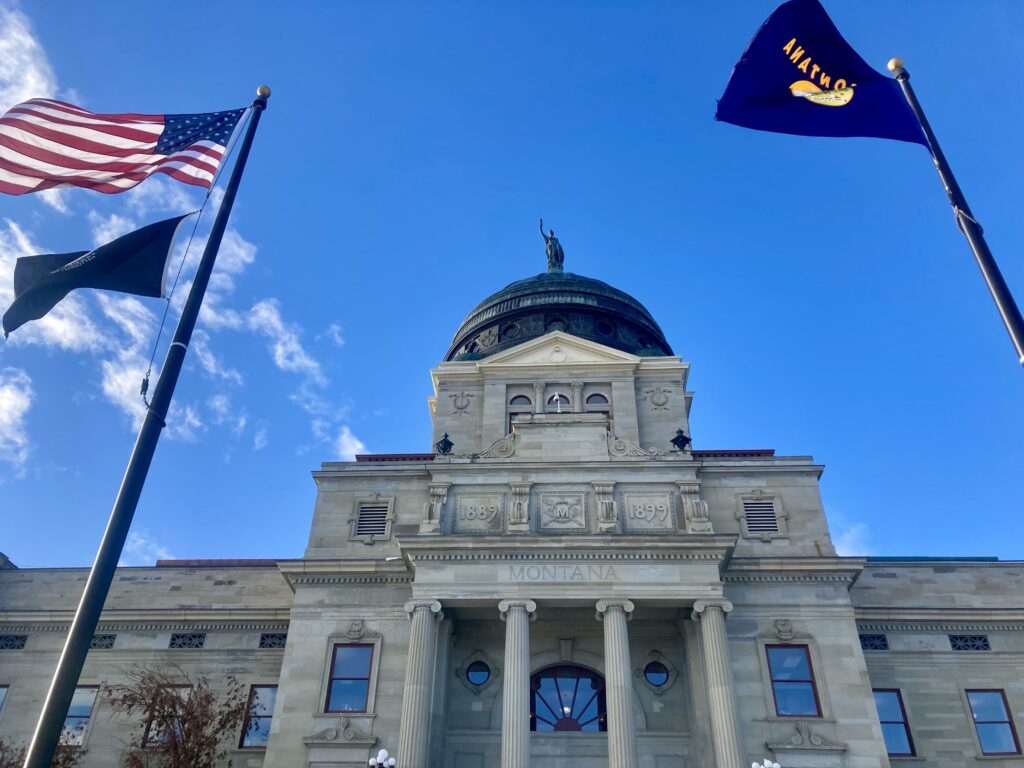
As CSG West prepares to convene two of its annual programs in Montana this year, last month’s state visit to the Montana State Capitol was an important opportunity to connect with members and legislative leaders.
CSG West staff Edgar Ruiz and Jonathan Lennartz enjoyed meeting with Senator Mike Cuffe, who shared a wealth of knowledge about the Columbia River Treaty and water policy issues along the U.S.-Canada border. Senator Cuffe’s insights will be valuable in shaping the programming for the Legislative Council on River Governance (LCRG), which will convene June 26-29 in Whitefish, Montana.
Joe Kolman, Director of Research and Environmental Policy in the Legislative Services Division, is this year’s co-chair of the Legislative Service Agency & Research Directors committee (LSA/RD), which is also meeting in Whitefish this fall. CSG West staff had productive meetings with Mr. Kolman and Jerry Howe, Legislative Services Executive Director, and appreciates their hospitality and support during the visit.
House and Senate leaders play an important role in appointing members to CSG West policy committees. Staff met with Senate President and Western Legislative Academy (WLA) alumnus Jason Ellsworth, Senate President Pro Tem Kenneth Bogner, and House Speaker Matt Regier to discuss appointments for the biennium, eligible candidates for the 2023 WLA program, and emerging policy trends in the legislative session.
One of the many highlights of the state visit included conversations with legislators about their policy priorities, as this feedback helps determine the most relevant issues to address during upcoming CSG West programs and events. As was fitting for Women’s History Month, three women from the Montana House offered particularly notable insights from their legislative work during the current legislative session.
Representative Marta Bertoglio is a former United States Air Force officer taking special interest in veteran affairs. Representative Bertoglio shared information about her legislation, House Bill 68, signed by Governor Greg Gianforte earlier this session, which aims to help relocated military families establish residency more readily for their child’s school enrollment.
House Minority Caucus Chair and Western Legislative Academy (WLA) alumnus, Representative Alice Buckley, described efforts to expand eligibility to a child care scholarship program for low-income families. Representative Denise Baum, a 19-year law enforcement veteran serving the last 14 years as a detective in Billings, discussed the impact of Montana’s Crisis Intervention Teams when responding to individuals who are experiencing a behavioral health crisis.
The WLA reception continues to be a highlight of the 2023 state visits. CSG West staff were delighted to host the many Montana legislators who have participated in the legislative training program, as well as interested applicants. Alumni shared their experience and the program’s continued influence in their legislative work.
CSG West offers special thanks for the floor introductions by Senate Pro Tem Kenneth Bogner and Representative Michele Binkley, respectively. We look forward to returning to Montana for the LCRG program in June!
The post On the Road with CSG West: Montana appeared first on CSG West.
Wanted: ‘Service attorneys’ for rural parts of Ohio where legal needs aren’t being met
Ohio this year will become the latest Midwestern state to offer financial incentives to fill the thinning ranks of public defenders and other attorneys practicing in rural counties.
Established under a bill signed by Gov. Mike DeWine in early 2023 (HB 150 of 2022), the Rural Practice Incentive Program authorizes the payment of up to $50,000 of an attorney’s student loans if the individual agrees to be a “service attorney” (a public defender, prosecutor or court-appointed counsel to represent indigent defendants) in an underserved community — defined as counties where the ratio of attorneys to total population is “equal to or less than” 1:700.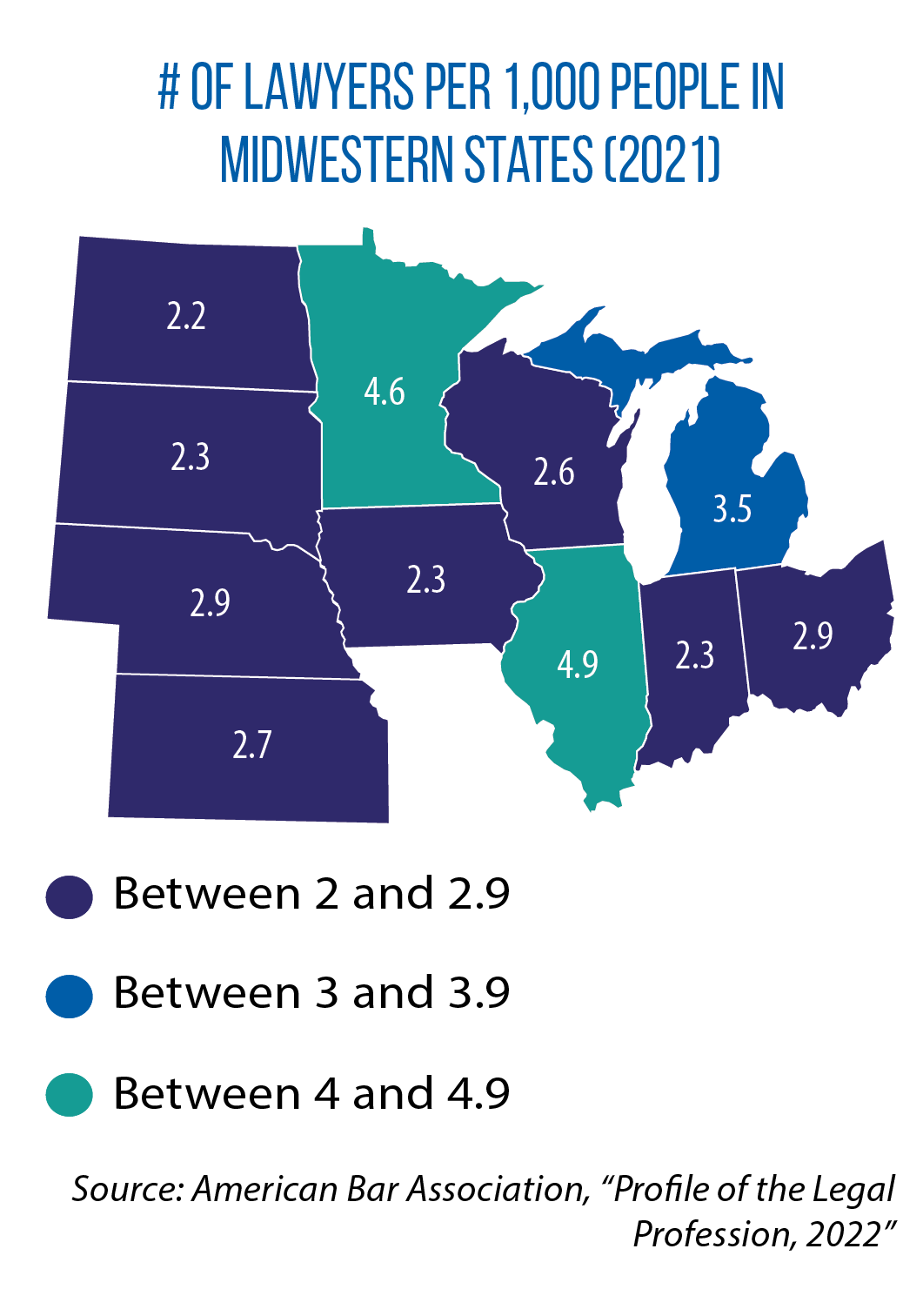
The Ohio Bar Association estimates that two-thirds of the state’s counties don’t have enough lawyers to meet the legal needs of local residents.
Participating attorneys will be able to claim an income tax deduction for amounts repaid by the program, which is receiving $1.5 million in state funds this fiscal year. HB 150 also creates a 17-person task force to recommend ways of improving Ohio’s indigent-defense system.
Since 2013, South Dakota has operated a program to recruit attorneys to rural areas, with the state and local governments sharing the costs. Participating lawyers get a payment equal to 90 percent of one year of the cost of resident tuition and fees at the University of South Dakota School of Law; in return, they must practice for five years in the rural county or municipality. Of 31 total participants, 15 have graduated out of the program; 12 of these 15 have stayed in their communities to continue practicing.
Late last year, the Kansas Supreme Court formed a 35-member Rural Justice Initiative Committee to study population and legal professional employment trends, as well as differences in unmet legal needs related to population density. In Kansas’ rural areas, the ratio of active attorneys to population is 1:808; that compares to 2:535 in urban areas.
Two counties in the state have no attorneys at all, five counties have one attorney, and 11 others have only two. The new committee in Kansas is expected to develop ideas on how the state can address this shortage in rural areas.
The post Wanted: ‘Service attorneys’ for rural parts of Ohio where legal needs aren’t being met appeared first on CSG Midwest.
With possible end to decades-old federal law, Minnesota revamps its Indian Family Preservation Act
Minnesota Gov. Tim Walz in March signed a bill enshrining language of the U.S. Indian Child Welfare Act (ICWA) in state law, months ahead of a U.S. Supreme Court ruling that could undo the federal statute that governs when, and under what circumstances, Native American children can be fostered or adopted by non-tribal parents. SF 667 sailed through the Legislature with just one “no” vote in the Senate.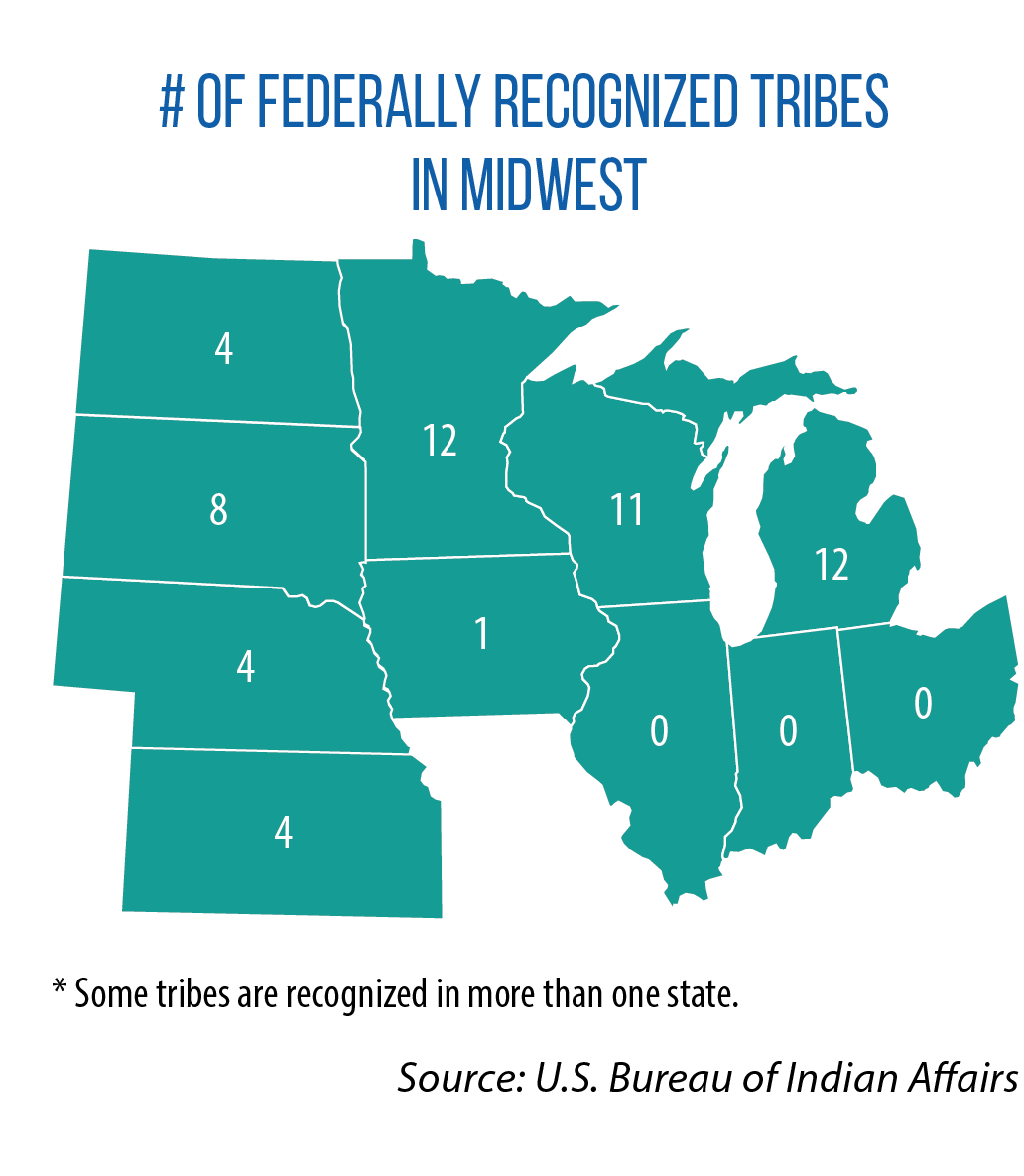
The new law’s goal is to ensure tenets of the ICWA remain in place in Minnesota if the federal law gets struck down. It does so through the addition and clarification of various language in the state’s existing Indian Family Preservation Act, says Minnesota Sen. Mary Kunesh, an enrolled member of the Standing Rock Lakota and chief sponsor of SF 667.
Minnesota’s Indian Family Preservation Act was enacted in 1985 to expand upon and strengthen various provisions of the ICWA. In the Midwest, Iowa, Michigan, Nebraska and Wisconsin also have comprehensive statutes that build on the federal law.
The ICWA recognizes tribal jurisdiction over foster care and adoption cases involving the children of enrolled tribal members. It establishes minimum federal standards for the removal of Native American children from their families, as well as preferences for the placement of children with extended family or other tribal families. It also institutes protections to ensure that birth parents’ voluntary relinquishments of their children are truly voluntary.
But a case before the U.S. Supreme Court, Brackeen v. Haaland, could overturn the ICWA. Plaintiffs in the case include the state of Texas and non-Native couples who tried to foster or adopt children with Native American ancestry, according to SCOTUSBlog, which provides independent analyses of cases before the court. The plaintiffs say child placement is the responsibility of states and that the federal law is racially discriminatory. Proponents of upholding the law say tribal membership is a political, not racial, category.
A ruling is expected to be handed down before the current term ends in June.
The post With possible end to decades-old federal law, Minnesota revamps its Indian Family Preservation Act appeared first on CSG Midwest.
State Options to Expand Buprenorphine Treatment for Opioid Use Disorder
By Kamren Gilbard and Jane Koppelman
More than 500,000 people died from an opioid-related overdose in the U.S. between 1999 and 2020, a more than seven-fold increase, and an estimated 2.7 million people were diagnosed with opioid use disorder (OUD) in 2020.
Methadone and buprenorphine — medications approved by the Food and Drug Administration to treat OUD — are the most effective treatments, as they are proven to reduce overdose deaths and illicit drug use. However, access to these lifesaving treatments is limited, with only 22% of people with OUD receiving any form of medication in 2021. While methadone is only available at highly regulated clinics — known as opioid treatment programs — buprenorphine can be provided by physicians, nurse practitioners and physician assistants in a variety of settings, such as primary care clinics and physician’s offices. Despite this, prescription rates for buprenorphine are low. Forty percent of U.S. counties lacked a buprenorphine provider in 2018, the most recent year data is available.
Striking disparities in buprenorphine access and use exist across racial groups. While OUD rates are fairly comparable among Black, Hispanic and white populations, buprenorphine providers are notably less likely to be located in communities of color. One national study of Medicaid beneficiaries diagnosed with OUD found that Black, Hispanic and Native American patients were significantly less likely to receive buprenorphine than white patients. Meanwhile, opioid fatalities are rising at faster rates for Black and Native American people than for white people. Research suggests there are numerous factors at play beyond the absence of prescribers, including a lack of culturally responsive or respectful care and a bias among providers who withhold buprenorphine from patients of color.
The Mainstreaming Addiction Treatment Act, which President Joe Biden signed into law as part of a larger omnibus spending bill in December 2022, intends to increase the number of providers willing to prescribe buprenorphine. The law removes a cumbersome requirement for providers to apply for a special Drug Enforcement Administration waiver (known as the X waiver), before they can prescribe the medication to patients with OUD. It also removes buprenorphine-specific training requirements for those prescribing the medication. Still, this law does not supersede state laws placing registration and training requirements on buprenorphine providers. As of August 2020 — the most recent year state-by-state data was compiled — four states required prescribers to register with the state and six states required prescribers to complete additional clinical training beyond what the federal government required under the X waiver.
Other state-level rules create even more barriers to accessing buprenorphine. Some public and commercial state insurers require patients to receive preauthorization from their health care provider to obtain buprenorphine, which delays immediate access to medication. As of 2018, 16 states required patients to undergo counseling as a condition of receiving buprenorphine, despite research showing that medication alone — even without counseling — lowers OUD overdose death rates and improves treatment retention. Further, low Medicaid reimbursement rates at the state level can create prescribing disincentives for providers. Additionally, buprenorphine providers often lack the capacity to offer or coordinate wraparound services that patients with OUD may need, such as recovery housing or transportation.
State Progress in Expanding Buprenorphine Access
Due to rising opioid deaths and a significant racial gap in treatment for people with OUD, among other concerns, policymakers in many states are working to remove barriers to treatment and increase access to buprenorphine.
Offering provider support
Many states implemented the hub-and-spoke model, which is designed to support providers treating patients with OUD. In the model, originally developed by the Vermont Department of Health, hubs are a small number of specialty treatment providers staffed to care for patients with severe and sometimes complex OUD. These hubs provide clinical guidance and a trusted referral to a buprenorphine provider. A larger number of spokes — primary care providers, OB-GYNs, community health center staff and others that can prescribe buprenorphine — are designed to support people with less severe OUD or for people transitioning out of hub care. The model encourages primary care providers acting as “spokes” to accept patients who they may have previously felt had overly complex medical circumstances. As of 2021, 27 states and territories have used State Opioid Response Grants from the Substance Abuse and Mental Health Services Administration to implement hub-and-spoke models.
Raising provider reimbursement rates
States have leveraged Medicaid reimbursement rates to encourage more health care providers to prescribe buprenorphine for OUD. For example, Virginia’s Addiction and Recovery Treatment Services (ARTS) program significantly raised Medicaid reimbursement rates for substance use counseling and allows Medicaid to cover care coordination and peer support services for OUD patients. Combined with other Medicaid reforms, ARTS increased the number of providers able to offer buprenorphine, as well as the number of individuals receiving medication.
Granting immediate access to buprenorphine
Delaying the start of medication for OUD increases a person’s risk of overdose and death. In response, a number of states have placed limits on rules that interfere with a patient’s immediate access to buprenorphine — such as prior authorization, counseling and initial intake assessment requirements — and have adopted a low threshold strategy, which allows a provider to immediately prescribe buprenorphine the moment a patient wants treatment, at a cost the patient can afford and without the provider placing additional conditions on receiving the medication. Policymakers across the country have implemented elements of this approach. As of April 2020, 21 states and the District of Columbia had removed buprenorphine prior authorization requirements for public or commercial health plans.
Missouri fully embraced low-threshold treatment methods. The state’s Department of Mental Health developed the Medication First program in 2017 for publicly funded treatment programs, which removed rules that required patients to either go to counseling or wait for an assessment visit before getting a buprenorphine prescription.
Reducing racial access disparities
One strategy addressing racial disparities in buprenorphine access is to increase the level of culturally responsive care offered by providers. In Pennsylvania, Medicaid requires its managed care plans to achieve, or work toward, the National Committee for Quality Assurance’s Multicultural Health Care Distinction. Recipients awarded this designation established plans that disaggregate patient data by race, ethnicity and language; provide culturally and linguistically appropriate services; provide services in languages that patients use; collect race and ethnicity data of plan providers; and implement strategies to improve health disparities.
Conclusion
Through a variety of mechanisms, state policymakers can increase access to lifesaving medications for opioid use disorder. The strategies described above — which often involve maximizing Medicaid coverage, modifying state regulations, passing legislation or appropriating funds — are among the options that state legislators and executive branch officials can use to help more providers offer buprenorphine and allow patients quick access to evidence-based treatment.




